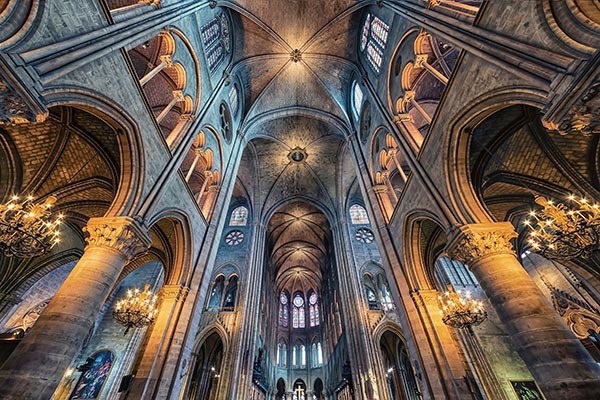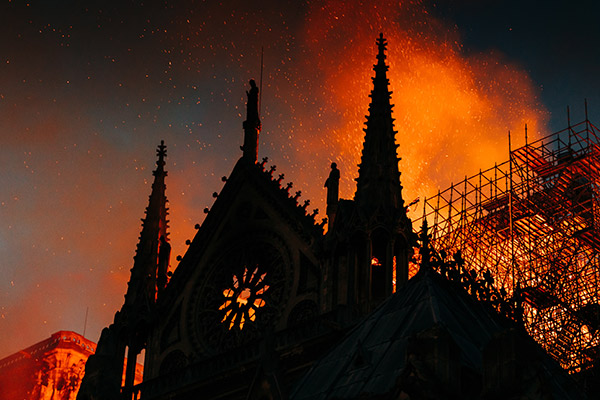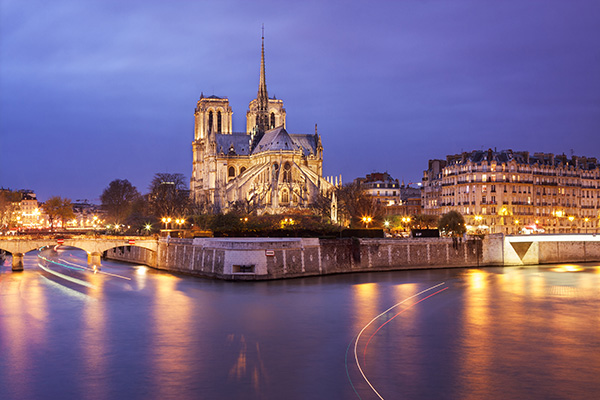Subtotal: $
Checkout-

The Path from Death to Life
-

In Praise of Repair Culture
-

Just Your Handyman
-

To Mend a Farm
-

The Home You Carry with You
-

Portraits of Survival
-

Three Pillars of Education
-

The Joy of Mending Jeans
-

Zero Episcopalians
-

Making Art to Mend Culture
-

Repairing Relationships
-

Forgiving the Unforgivable?
-

Not Everything Can Be Fixed
-

A Life That Answers War
-

Forgiving Dr. Mengele
-

Editors’ Picks: Faith, Hope and Carnage
-

Editors’ Picks: Klara and the Sun
-

Letters from Readers
-

My Liberal Arts Education in Prison
-

One Parish One Prisoner
-

What’s a Repair Café?
-

Analog Hero
-

The Sacred Sounds of Hildegard of Bingen

Rebuilding Notre-Dame Cathedral
It’s not the first time it has risen from the ashes.
By Elizabeth Lev
November 24, 2023
Available languages: Español
Next Article:
Explore Other Articles:
One thing the Church knows a lot about is rebuilding. Indeed, it is part of the genetic code of Christianity. Ever since the persecutions under the Roman Empire, where their meeting places were destroyed and their congregations killed, Christians have had to reconstruct. Whether assailed by natural disasters or man-made catastrophes, external hostility or internal corruption, Christians have learned to pick up the pieces and create something new, a process Pope Benedict XVI once described as “a Church purified by penance and renewed in pastoral charity.”
Looking through that lens, the rebuilding of the cathedral of Notre-Dame in Paris after the devastating fire of April 2019 should be par for the course. Nonetheless, a sense of trepidation surrounds the restoration. President Emmanuel Macron is confident that the cathedral will be ready for its first Mass by December 2024, but many are not so sanguine.
Certainly, it is not a question of the groundworks. When Maurice de Sully, Bishop of Paris, began the construction of Notre-Dame in 1163, he laid its foundations to a depth of thirty feet – sinking them into an ancient pagan temple that once stood on the site and the remains of a seventh-century church of the same name. The first Notre-Dame had already seen destruction at the hands of the Vikings in 856, only to be reconstructed ten years later, and designated as the episcopal seat. The roots of Notre-Dame are remarkably stable.
What has many people concerned is how the new grafting will take to those foundations, given the radically transformed contemporary climate.
Macron’s plan is to restore the cathedral as it was, although “as it was” refers to a dramatic and controversial restoration in the nineteenth century. Historically however, any work on Notre-Dame has always attracted critics; if the purely conservative mentality had always prevailed, it would still be a small, clunky structure with few windows and a trussed roof.

Photograph by Stockbym, stock. adobe.com
But the tempest of activity around Macron’s deadline bespeaks haste, the antithesis of Gothic construction. The builders of Notre-Dame undertook a long-term commitment to constructing something perfect, and the sponsoring bishops were aware that they would probably not live to enjoy the fruit of their vision in this world. The multi-generational efforts on the part of masons, decorators, and patrons constitutes a large part of our modern fascination with these cathedrals. A fast-tracked project to satisfy what might be construed as the hubris of a ruling party does not suggest ideal conditions to replicate the basilica’s former glory.
Perhaps it is the apparent fragility of Notre-Dame, with her lacy crockets, kaleidoscopic windows, and dainty flying buttresses, that brings out our chivalrous nature. Surely this miraculous mirage of a church can’t defend herself against the currents of modernity, determined to reduce her to a tourist attraction. A space-age spire? A video screen in the chapel? Desecration! Many of the projects proposed immediately after the April fire followed in this ludicrous vein: a swimming pool, a commercial apiary.
While these more outlandish ideas were not adopted, the plan by Guillaume Bardet chosen in June 2023 for the interior has drawn plenty of fire, with its sleek geometric forms in dark bronze with little ornament. His five pieces – baptismal font, altar, celebrant chair, ambo, and tabernacle – are blocks and curves, essential shapes to “resonate with conviction for Catholics and captivate the attention of non-Christians.” Some have lamented that it resembles “’70s Ikea design”; others called it a “ransacking” and an “embodiment of the decline of the faith in France.” Perhaps its greatest problem is that in trying to be meaningful for all, it lacks identity, and thus becomes irrelevant. It’s an expensive – to the tune of six million euros – series of works that would be as at home in the lobby of an upscale hotel as in the cathedral that once embodied the French Catholic faith.
The great grey lady of Paris, however, can handle herself. Indeed, in times of trouble, Parisians flock to her. She has been the comfort of kings; eighty crowned heads of France have passed through her portal. She has been the refuge of the people who implored her aid in everything from famine to the Nazi occupation. She has been the welcome of pilgrims who flocked to the city to see its famous relics, including the crown of thorns that Saint Louis IX purchased in 1238, believing it to be the original from Christ’s crucifixion. It has been housed in the cathedral as of 1801.
While it seems certain that the church will be rebuilt, the real question is: Can the Church be rebuilt?
For eight hundred years she has stood, watching life and death from her sacred perch. “Sacred,” meaning “set apart,” is in this case the Île de la Cité, a boat-shaped island in the Seine River linked to the rest of the city by ten bridges. A sacred vessel in a secular sea, Notre-Dame seems to glide through the historical events that have unfolded along her shores. A millennium of monarchy, two emperors, five republics – Notre-Dame has watched men try to navigate government with varying degrees of success for centuries, her presence serenely reminding them that the only true path is the one to Jesus Christ. Her 226-foot spire stood like a mast inviting Parisians to seek refuge in the barque of Peter amidst the uncertain shoals of life.
Modernity has challenged her stature. In 1889, the wrought-iron shaft of the Eiffel Tower soared past Notre-Dame’s sculpted spire to an astonishing 984 feet. In 1989, in honor of the bicentennial of the French Revolution, Paris welcomed the Arche de la Défense, a 360-foot-square monument large enough to encompass the cathedral. Yet while Notre-Dame burned, Parisians sang the Ave Maria between tears and prayers – it’s hard to imagine the Arche de la Défense eliciting such love.
The cathedral was consecrated in 1189 during the golden age of theology. That period saw the rise of the universities and the scholastics, when men wrestled with thinking systems to better understand their Maker. Notre-Dame’s design reflected that era of learning, geometrically organized and marked by innovation – the world’s first flying buttresses are believed to have been constructed for the church. The complex framework, penetrated by transcendent light, was reflected in the thought of Saint Thomas Aquinas as he created an intellectual architecture to draw reason toward faith. Like Aquinas’s Summa Theologica, writes art historian Erwin Panofsky, “the High Gothic cathedral sought to embody the whole of Christian knowledge, theological, moral, natural, and historical, with everything in its place that which no longer found its place suppressed” and arranged “according to a system of homologous parts and parts of parts.”
This complexity was also echoed in the music of Notre-Dame, the cradle of Western polyphony. As the masons erected soaring vaults and broad arcades, twelfth-century composers Leoninus and Perotinus combined many voices, each an equal and independent melody that together formed a whole greater than the parts, to create a sublime harmonic experience that expressed the individual and corporate Christian life.
Notre-Dame was built during the great Marian era, when our Lady was honored in every town and village, and increasingly became a focus of dedication in the cathedral church. Twelve years after its inauguration, Saint Dominic began to preach the importance of the rosary, which would become the quintessential Marian prayer. In 1225, less than two decades later, the first rose window was erected in the western façade of Notre-Dame. Petals of cobalt and crimson glass bloom around the Madonna and Child at the center. The images represent the twelve tribes of Israel, virtues and vices, human labor, and heavenly movements. It is a vision of the universe ordered around the Mother of God. Notre-Dame of Paris represented the best of this era, a vision of hope and beauty in a world of short life spans and endemic poverty.
The fateful 2019 fire was ignited in the “forest,” in the timber roof laid into place between 1220 and 1240. The internal temperature of the structure reached 1212 degrees Fahrenheit, and ultimately the central section collapsed, sending the spire crashing to the ground. The high-definition television footage allowed people to experience the fire intimately, and the horrific scene drew a gasp from the world. It seemed all was lost, yet as the fire was quenched and the damaged was assessed, a ray of hope emerged. The façade and apse remained intact, only 5 to 10 percent of the art was lost, and the crown of thorns had been salvaged.
The April blaze was just the latest in a long series of disasters the cathedral has survived – and unlike many others, it was impersonal and accidental. The year 1548 saw the first serious sally against Notre-Dame when the Huguenots – Protestant followers of John Calvin – attacked the statues they considered idolatrous. While the 2019 fire spared most of the art, the Huguenots targeted it, smashing most of her statues to the ground.

Photograph by Guillaume, stock. adobe.com
Yet, despite the loss of so many other works of art, the statue of the Virgin of the Pillar survived. Carved in the early fourteenth century in the sinuous Gothic style and hidden away in the canons’ cloister, she is the most beloved of the thirty-seven statues remaining inside the church. She has weathered the Reformation, revolutions, indifference, and the inferno of 2019, and continues to receive the prayers and petitions of Parisians as well as pilgrims.
In the sixteenth century, Notre-Dame’s restoration came from an unlikely source, the former Huguenot Henry IV of Navarre, crowned king of France after he returned to Catholicism in 1593. The renaissance of the cathedral was the centerpiece of the royal program to make Paris “beautiful, tranquil … and a wonder of the world.”
The next acts of destruction came from “friendly fire,” as it were. In the seventeenth century, Notre-Dame – then four centuries old – was considered that “outrageous and insupportable fashion of building” by those who wanted a new, more contemporary edifice. Drapery covered the walls during ceremonies to hide what had become an embarrassingly antiquated style, like an eccentric aunt to be hidden from guests. King Louis XIV, crowned in 1643, had vowed to defend the Catholic faith, but as his fame as Sun King grew, he sought to eclipse Our Lady. Clearing the sanctuary of the old rood screen and choir, he raised it like a stage and sheathed it in marble to mimic the Baroque churches of Italy. His new high altar was surmounted by Nicholas Coustou’s Descent from the Cross, while Coustou’s brother and uncle produced the kneeling statues of Louis XIV and his father on either side.
Even the canons of the cathedral managed to inflict their own wounds – in 1756, deeming the church too dark, they removed the stained glass, leaving only the rose windows, and white-washed the walls. This demolition heralded the Enlightenment: an apparently innocuous call to monarchs to be guided by the light of reason.
This man-made light was soon overcome by darkness as the French Revolution expunged traditional faith as an arcane superstition. Notre-Dame was seized in 1793, and Paris’s archbishop, Jean-Baptiste-Joseph Gobel, tried to placate the forces of secularism by divesting himself of his clerical authority and donning the red cap of the revolution. Despite his conciliatory efforts, he was executed soon after, the first of several who would die over the next hundred years of strife between politics and religion.
On January 21, 1793, King Louis XVI, who had once hosted Thomas Jefferson and John Adams in the cathedral, was decapitated. The full fury of the revolution was unleashed. Religion was outlawed soon after, and anything recalling either sovereigns or Christianity was fair game for the vandals of the revolution. Spying the array of the twenty-eight kings of Judea on the façade, the new regime vented its anti-monarchical frenzy on the thirteenth-century statues, which were dragged to the ground and summarily beheaded. The heads were somehow spirited away and found later, in 1977, hidden away in a Parisan home.
The edifice may have remained intact, but Notre-Dame was violated. Its sacred images were desecrated, and its altars repurposed for the worship of Reason. This new cult, however, soon abandoned “reason” to use the sacred space for bacchanals that, many attested, devolved into debauchery.
In perhaps its darkest moment, Notre-Dame was shut down and sold at auction, its new owner intending to demolish the building for materials (as had been done with the monastery of Cluny).
Napoleon halted this execution, since he intended to use the cathedral’s majesty as a backdrop for his own propaganda. His coronation as emperor on December 2, 1804, where he seized the crown from the hands of Pope Pius VII to put it on his own head, took place in the cathedral, its dilapidated walls and empty pedestals disguised by gilt stands and velvet banners. Napoleon’s interest in Notre-Dame, however, was fleeting: wounded and abandoned, the church stood silently on her island.

Photograph by unknown1861, stock. adobe.com
Rebirth for Notre-Dame came from an unexpected ally. Victor Hugo, while baptized a Catholic, had grown increasingly hostile to that faith. Yet, it was his 1831 novel, The Hunchback of Notre-Dame, that called attention to the plight of the church. An impassioned plea for its restoration eventually persuaded the state to act, and in 1844 Eugène Viollet-le-Duc and Jean-Baptiste Lassus were selected to oversee the 5-million-franc reconstruction of the cathedral.
The motivation of the poet and the architects was to revive merely the form, not the faith. “The cathedral itself, once so imbued with dogma, invaded now by the commonality, by the spirit of freedom, escapes from the priest, and falls under the dominion of the artist,” Hugo wrote. “The four walls belong to the artist. The stone book belongs no more to the priest, to religion, to Rome, but to imagination, to poetry, to the people.”
Viollet-le-Duc drew inspiration from Hugo, adding gargoyles, chimeras, and figures not part of the original structure. Placing his own portrait as “doubting” Saint Thomas among the apostles on the spire, he celebrated his aloof stance from the religion even as he made his name and fortune by restoring its buildings. The nostalgia of the restoration was not for a French church rooted in theology and liturgy, but for a vague nationalistic ideal. The 1905 Law of Separation of Church and State codified this vision, leaving the state as Notre-Dame’s owner and the clergy merely her tenant. Of the 13 million yearly visitors to the cathedral, practicing faithful were decidedly the minority, and the hodgepodge of decoration on the interior did little to illuminate the beliefs and stories that inspired the thirteenth-century builders.
It was that largely secularized structure that burned in Paris on April 15 – a fitting symbol, perhaps, of modernity’s estrangement from religion. Today only 15 percent of French identify as practicing Catholics and of those 4.5 percent attend Mass regularly. While it seems certain that the church will be rebuilt, the real question is: Can the Church be rebuilt?
Nowhere does Guillaume Bardet, the decorator of the cathedral, profess any kind of faith. Perhaps for that reason his proposed interior, while sufficiently abstract to be politically inoffensive, does little to gather the people of God. Notre-Dame was built to celebrate the woman who gave birth to the Word Made Flesh, the unique message and identity of the Christian faith. An art that refuses to accept the Incarnation will have difficulty proclaiming the Good News. Scripture is central to the history of Christianity, and in a world where most people don’t know the stories that constitute the history of salvation, abstract images will not be able to teach. They just offer soothing placebos formed of concepts like “freedom” and “fraternity.”
And they lack a sense of wonder. Notre-Dame was meant to inspire worship through wonder, the dazzling perception of the divine through the senses to the soul. Bardet’s dark, heavy pieces seem earthbound, and in an age tied to the material and the utilitarian, the liturgical structures seem to mire mystery in earth, instead of reaching toward heaven.
Yet mysteriously, the cathedral still proclaims the faith that spurred on its original builders. Even if the stones (or bronze) of its modern restorers will not preach, as long as Notre-Dame stands, she will favor those who, in the words of Saint Peter, are “ready to give a reason for the hope that is inside.”
Already a subscriber? Sign in
Try 3 months of unlimited access. Start your FREE TRIAL today. Cancel anytime.

































